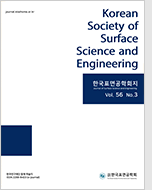
- Past Issues
- e-Submission
-

2021 Impact Factor 1.766
5-Year Impact Factor 1.674
Editorial Office
- +82-2-563-0935
- +82-2-558-2230
- submission@kssse.or.kr
- https://www.kssse.or.kr/

2021 Impact Factor 1.766
5-Year Impact Factor 1.674
The Korean Society of Surface Science and Engineering 2023;56(5):299-308. Published online: Oct, 31, 2023
DOI : 10.5695/JSSE.2023.56.5.299
In this study, phosphorus (P)-doped nickel cobaltite (P-NiCo2O4) and nickel-cobalt layered double hydroxide (P-NiCo-LDH) were synthesized on nickel (Ni) foam as a conductive support using hydrothermal synthesis. The thermal properties, crystal structure, microscopic surface morphology, chemical distribution, electronic state of the constituent elements on the sample surface, and electrical properties of the synthesized P-NiCo2O4 and P-NiCo-LDH samples were analyzed using thermogravimetric analysis-differential scanning calorimetry (TGA-DSC), X-ray diffraction (XRD), field-emission scanning electron microscopy (FE-SEM), energy dispersive X-ray spectroscopy (EDS), X-ray photoelectron spectroscopy (XPS), cyclic voltammetry (CV), galvanostatic charge-discharge (GCD), and electrochemical impedance spectroscopy (EIS). The P-NiCo2O4 electrode exhibited a specific capacitance of 1,129 Fg-1 at a current density of 1 Ag-1, while the P-NiCo-LDH electrode displayed a specific capacitance of 1,012 Fg-1 at a current density of 1 Ag-1. When assessing capacity changes for 3,000 cycles, the P-NiCo2O4 electrode exhibited a capacity retention rate of 54%, whereas the P-NiCo-LDH electrode showed a capacity retention rate of 57%.
Keywords NiCo2O4, Hydrothermal Method, Supercapacitor, Phosphorus Doping, Electrode, Energy Storage Device